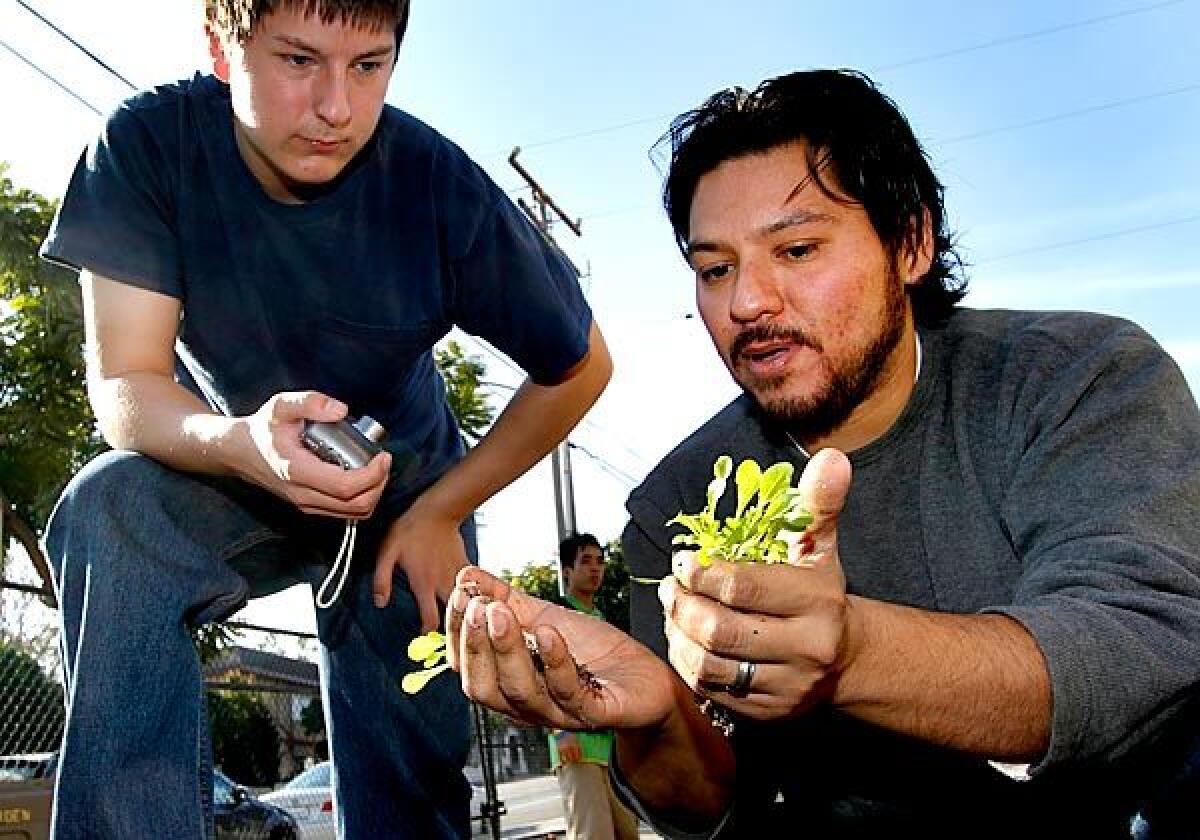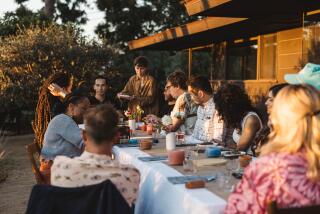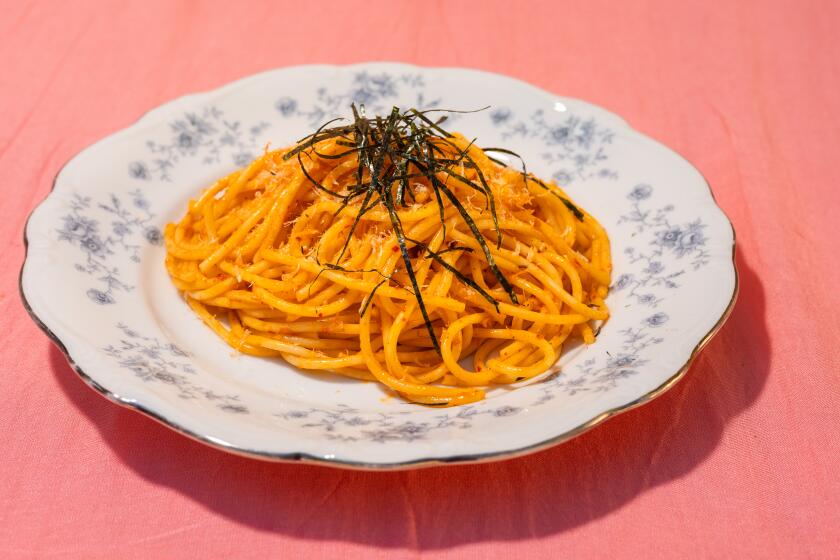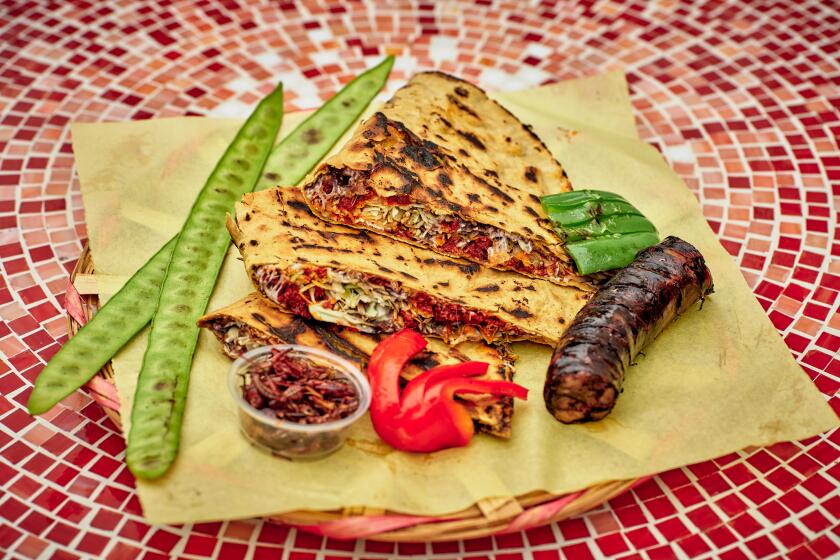Students get hands-on lesson in nutrition

Over months of Friday mornings, the teenagers dug holes for kale and eggplant. They staked and tied vines heavy with tomatoes and pulled out the plants when the season was done.
Working alongside them on a narrow strip of schoolyard outside Olympic High in Santa Monica was Ray Garcia, the executive chef at the swanky restaurant Fig in the Fairmont Miramar Hotel, who came each week to the school to teach and to learn and to try to open the teenagers’ eyes and palates.
Quietly, he urged them along, talking about the plants and his work. Look at this, taste that. They harvested tiny heirloom tomatoes and fragile baby lettuces for a classroom salad. What the students didn’t eat went to his restaurant kitchen.
That made the work of growing food real.
But it didn’t necessarily make the students so eager to eat it. Some didn’t want to taste any of the 16 varieties of heirloom tomatoes they grew. They looked with reticence at the Black Hawk, Defender and other unusual varieties of lettuce.
“These kids feared food. Not only are they disconnected from it, they fear it,” Garcia observed one Friday. “They have few reference points to describe their culinary experiences.”
But slowly, they came around. And one warm evening last week, Garcia gave seven of them their graduation present: a sophisticated, eye-opening taste of the meaning of farm to table.
They arrived at sunset, shy but game. Asked what nice restaurants they’d been to, one said Cheesecake Factory and another offered Red Lobster.
“Hi, guys. Welcome to my house,” said Garcia, wearing his chef’s jacket. “You’re going to get hit with a lot of food tonight. Try what you like.”
Garcia, an East L.A. native who gave up law school to become a chef, shows his commitment to local food in Fig’s farm dinners and the restaurant’s garden. Lists at the bottom of the menu note what’s “just arrived,” is “in peak season” and “coming soon.” In a review, Times restaurant critic S. Irene Virbila praised his “bright California cooking.”
At the students’ table, in a private room, waiters put down plates of cheese and charcuterie; blistered lettuce with anchovy and a sliver of Reggiano; chicken and prosciutto croquettes. One waiter suggested putting honey on the Camembert.
Garcia brought the group into his kitchen, which serves 900 people a day. He talked about how his staff got their jobs. It’s the year’s first farm dinner, so later, Juan and Armando Garcia (no relation) from Garcia Organic Farm in Fallbrook stopped by to talk with the students.
For dinner, the teenagers chose scallops with Satsuma mandarins and cauliflower; short rib and pancetta meatloaf; braised oxtail with oranges and prunes; and other dishes.
Krystal Kelley, 17, had been afraid to taste a tomato, and there she was eating beef cheeks, braised duck, Brussels sprouts. Her family won’t believe it, she said. Max Marrone, who pledged to try anything but fish, tasted octopus. A couple of them ate — and liked — tongue before they knew what it was.
Frequently, Garcia came by to ask how they liked his food (which got a big applause after dessert). Several used their phones to photograph their dishes. Manager Larry Scher encouraged them to try whatever appealed to them. Keith Nguyen took him up on that and ordered three entrees to share around the table.
“I’m so happy,” said Nguyen, 18. “I’m just going to brag about this all day tomorrow.”
Though their feast was made with many freshly harvested ingredients, it was actually months in the making.
Garcia came to Olympic High last summer, after meeting the school district’s nutrition specialist and the farmers market manager. He later became part of First Lady Michelle Obama’s program that connects chefs and schools — more than 2,000 chefs are taking part, the U.S. Department of Agriculture said — as part of her campaign to end childhood obesity.
Olympic is the district’s continuation high school, for about 140 students who need to make up credits, want a more individualized program or are at risk academically or in other ways. Its garden is part of the district’s 13-year-old school garden program and gets help from master gardeners Debbie Harding and Lucia Burke.
“I started out to help and to teach. But it’s eye-opening. I’m learning a lot more,” said Garcia, who was dismayed when the students discussed their favorite energy drink or snacked on candy. With a father who has diabetes and brother a candidate for it, Garcia hopes to bridge the students’ disconnection between what they eat and what they’re growing.
On Fridays, as students came and went over a few hours, there was plenty of flirting, snacking and loafing. But Anthony Fuller, the science teacher in charge of the garden, often intervened: Get to work or go back into school.
Andrew Jones, 17, started working in the garden because “Mr. Fuller said we’ll get extra points.”
“By the second day, I was really into it. I came, like, every single day,” Jones said. “The stuff you buy from a fast-food place or a restaurant — it starts from here. You can see the effort people put into food for the whole community.”
Not everyone took to it. One girl, who was squatting gingerly, fussed so her low-rise jeans didn’t slip down too far. She didn’t want to get dirt on her pants or her hands. Soon she was on her way back inside.
Garcia mostly went about his business, and students wandered over to join him at one of the half-dozen small garden beds. He got three boys to move some lettuce plants from one of the half-dozen beds and prep the soil for eggplant, collards and broccoli.
He asked them to consider what they’re growing versus what they see in the supermarket or on a fast-food burger. He and Fuller talked about flavor and bugs and climate.
Fuller hopes the students see Garcia as a role model, and he wants them “to step outside their comfort zone. That’s how they’ll succeed.”
One fall morning, the students took big bowls of tomatoes and lettuce from the garden into Fuller’s classroom, where Garcia showed them how to make mozzarella.
“This is probably different from what you see on pizza. It’s not like Domino’s or Pizza Hut,” Garcia said.
At first, only a couple of students stepped up to make cheese; most said they’d just watch. But soon everyone wanted a bowl of hot water and some curds to stretch and smooth and finally form into a ball.
The cheese, tomatoes and lettuce were made into a salad.
“This might be the best salad I’ve ever eaten,” said Tobias Herber, a junior who moved here from Germany in 2004. “The garden is very therapeutic and relaxing. It gets you out of the routine. If I could get paid to do this, it would be awesome.”
The garden remains small, but the dreams are big. Fuller and Garcia want to see the students sell their produce, perhaps at a flea market that sometimes uses the school grounds. Garcia would like to see them cooking, maybe for school lunch.
For now, the garden is getting a reputation, one likely to be enhanced as word spreads about the dinner at Fig. As Krystal Kelley said of their patch of land: “This is the place to be.”
More to Read
Eat your way across L.A.
Get our weekly Tasting Notes newsletter for reviews, news and more.
You may occasionally receive promotional content from the Los Angeles Times.











